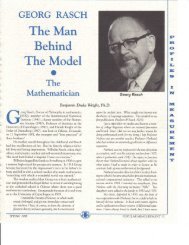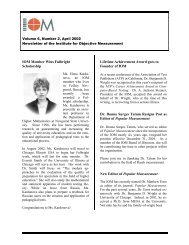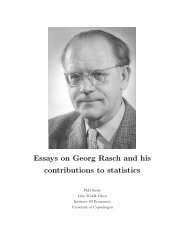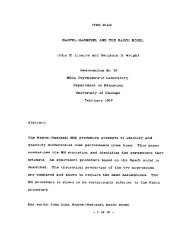Memo # 1964-2 PDF - Verio
Memo # 1964-2 PDF - Verio
Memo # 1964-2 PDF - Verio
Create successful ePaper yourself
Turn your PDF publications into a flip-book with our unique Google optimized e-Paper software.
To exemplify we may consider five subjects with the parameters<br />
o.ol, o.lo, l.o, lo, loo,<br />
being given three items with the parameters<br />
1.o, 2.o, lo.<br />
The probabilities of correct answer become:<br />
c<br />
1 l.o 2.o lo<br />
o.ol o.ol o.o2 o.lo<br />
o.1 ; o.lo o.17 o.5o<br />
1.o o.5o o.67 o.89<br />
lo o.89 o.95 o.99<br />
loo o.990 o.995 0.999<br />
where it should be noted that for each item the probabilities vary<br />
from small values to almost unity.<br />
Now the theoretical correlation coefficient in a population of<br />
individuals equals the correlation coefficient of the probabilities,<br />
calculated with the parameter distribution as a weight function.<br />
It follows that even with moderate variation of E,, from o.1 to lo<br />
say, we should obtain quite high correlation coefficients. But,<br />
of course, if is the same - or practically the same - for all<br />
individuals the correlation coefficient becomes o or close to it,<br />
Thus, the model suggested is not at all at variance with the well<br />
known findings, but,clearly, under this model the correlations<br />
do not represent intrinsic properties of the items, being mainly<br />
governed by the variation of the person parameters.<br />
In order now in a more positiv&Iply to elucidate what ie implied<br />
by our assumption we shall turn attention to the very basic concept,<br />
that of probability.<br />
Probabilities are often thought of as a kind of formalization or<br />
idealization of relative frequencies. In the model suggested this<br />
point of view does not apply directly since large scale repetitions<br />
of a test are not conceivable. However, in modern xiomatics of<br />
probability theory, initiated by A.N. Kolmogoroff 1 ), probabilities<br />
are just real numbers between o and 1 that obey a certain ScA of<br />
rules. Within that framework we may very well allot probabilities<br />
to events that. cannot be repeated, such as the two possible responses<br />
of a person to an item (i) in an intelligence test. With a view<br />
to the following discussion we shall temporarily use the notations<br />
p{(+)<br />
i i<br />
} j and p g); for such probabilities for a given person.<br />
1) See e.g. W. Feller: An Introduction to Prob - bilit, Theory<br />
,nd Its .1pplic'tions. I. Second.ed. ..iley. De.; York 197.<br />
(Introduction .nd ch pt. I, IV, V.









